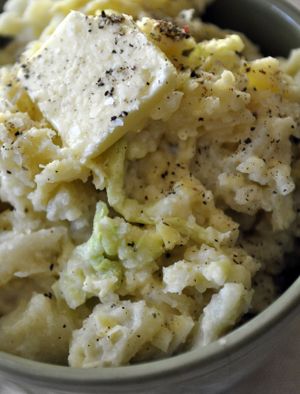No green beer here
In honor of St. Paddy’s Day, The Spokesman-Review Food section asked readers to share their favorite Irish culinary experience.
At stake: half-dozen Irish-themed cookbooks.
Here are – in no particular order – the 250-word essays from all six cookbook winners.
Burns-ing down the pub
The best Irish dinners took place when I went to Syracuse, New York, for my mother’s birthday. Every other year we would go to Jimmy’s Coleman Pub in Tipperary Hill about five blocks from the ancestral home of the Burns family.
I would have corned beef, cabbage, steamed carrots and a Guinness. I know this is very simple, but the special part of going to this pub was that my father talked of having his first beer there when he could put a nickel on the bar. He was 6 or 8.
We went to that pub until my mother reached 92. Always a wonderful time.
Jim Burns, Spokane
Spirit of Ireland
Eight of us spent two weeks in November 2014 in County Clare, Ireland. Stopping at small pubs throughout the trip allowed us to enjoy seafood chowder, Guinness stew, brown bread and the best fish and chips to ever grace our palates.
The most memorable was in the small, picturesque port of Dingle in the southwest region. The seafood chowder and brown bread were wonderful.
But when I went to the bar to pay the tab, I noticed a bottle of Dingle gin that, indeed, is distilled there using local herbs and spices. The bartender was generous to offer me a taste.
So now, of course, a bottle of Dingle gin assumes a prominent place in our bar.
Michael Brandt, Greenacres
Rambling pub rover
I’ve enjoyed lots of Irish dishes at various Irish pubs throughout the decades, starting with Harp and Heather (now long gone) in Vancouver, British Columbia. The Harp had a great lamb stew with a Guinness base, thyme and sage. Very tasty.
I made yearly pilgrimages to F.X. McRory’s in Seattle for a long time. It has four great Irish dishes on St. Patrick’s Day: traditional Irish stew, corned beef and cabbage, a corned beef sandwich (my favorite) and beef-and-Guinness shepherd’s pie, all of which are wonderful. The sandwich was served on dark rye with Thousand Island dressing. It was tart and dense – and just salty enough that you needed another Guinness.
When I moved to Spokane in August 1981, I discovered Ahab’s Whale. It didn’t have an Irish pub look, but it booked singers like Brian Bowers and Dan Maher, who sang folk and Celtic music. On St. Patrick’s Day, Ahab’s served one of the best corned beef sandwich on rye that I’ve ever eaten. The corned beef was cooked with Guinness, and there was a touch of horseradish along with the Thousand Island dressing.
Part of what makes an Irish dish great is the ale or stout that you serve with it. More recently, I go to the Viking Bar and Grill in Spokane for a pub atmosphere. Plus, it has a great Reuben, which pairs well with Quilter’s Irish Death or Skull Splitter.
Cryss Thain, Rathdrum
Farl three well
I lived in Ireland for a year back in 1970 and have many wonderful food memories: fresh Dublin Bay prawns, sweet and moist Irish brown bread, comforting colcannon.
But my favorite food of all was Irish potato farls.
These are made from leftover mashed potatoes. A few other ingredients are add, then the mixture is rolled out like cookie dough, cut into squares and fried (usually in bacon fat) until they’re golden brown on the outside and soft and tender on the inside.
They’re served for breakfast alongside rashers of bacon, eggs and fried tomatoes or baked beans.
I have tried multiple recipes over the years and found one that came close, but maybe what is missing is the soft Irish rain, the lilt of the language and the smell of gorse in bloom.
Still, when I make a batch and cut into one for my breakfast, I’m almost back in the Ireland I remember and love so well.
Dianna Shimizu, Deer Park
A mighty wind – and stew
It was a mighty strong wind that blew and howled as my adopted English family and I caught the ferry from Pembrokeshire, Wales. By the time we reached the dock at Waterford, the seas weren’t the only thing churning. Even the most seasoned travelers were feeling the effects of the roller-coaster ride, but my queasiness was soon superseded by the fact that I WAS IN IRELAND.
As we drove off the ferry and up the lane, I was astounded by the greenest grassy fields I had ever seen. That first magical moment of glimpsing one-story, thatched-roof cottages surrounded by old rock walls will remain etched in my mind forever.
We motored toward Limerick, but pulled over at a beside-the-highway tavern in Kilmeaden, hoping for lunch. The Long Haul was old, picturesque and spotless, and as we walked in we were greeted by the proprietor and a member of his staff. Their welcome made me feel as though I was a long-lost relative.
The “lunch of the day” happened to be traditional Irish stew, served piping hot in wide bowls with enormous hunks of Irish soda bread and butter. I can still smell the savory broth filled with tender chunks of braised lamb, quartered carrots, chopped onions and celery, and honest-to-goodness Irish potatoes. I don't think there were any seasonings other than salt and pepper, but I’ve never been able to duplicate that flavor. I can’t help but think the atmosphere contributed to the taste.
Violet Holland, Lind
Not ashamed
I was born Rose Eileen Kelly. My father Jim was 100-percent Irish. So we lived, breathed and ate Irish.
Corned beef and cabbage, shepherd’s pie and Irish brown bread, all made by my German mother, were always on the menu. We listed to Bridie Gallagher albums during our evening meal.
But my fondest memory was what my dad said to us six children, every night, as we sat down to the dinner table: “What would you be if you weren’t Irish?”
We would say, “I don’t know,” in unison.
And, with a twinkle in his eye, he would answer, “You’d be ashamed of yourselves!”
Rose Kelly Rhoades, Spokane

